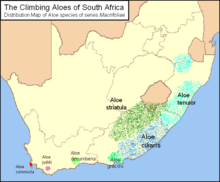Aloe decumbens
| Aloe decumbens | |
|---|---|
| | |
| Conservation status | |
| Scientific classification | |
| Kingdom: | Plantae |
| Clade: | Angiosperms |
| Clade: | Monocots |
| Order: | Asparagales |
| Family: | Xanthorrhoeaceae |
| Subfamily: | Asphodeloideae |
| Genus: | Aloe |
| Species: | A. decumbens |
| Binomial name | |
| Aloe decumbens Lam. | |
 | |
Aloe decumbens (the Langeberg Rambling Aloe) is a sprawling, rambling aloe that is endemic to the fynbos vegetation of the Langeberg Mountains near Riversdale in the Western Cape, South Africa.
Description

This aloe is decumbent - as its name suggests - and its long, thin branches sprawl along the ground and over the rocky outcrops where it grows. Its bright scarlet flowers appear on and off throughout the year, regardless of season.
Natural distribution
Aloe decumbens survives in small, isolated pockets in the Langeberg mountain range of the Western Cape, South Africa. Of the eight isolated sub-populations, one exists as far west as the vicinity of Swellendam, and one population is protected in the Boosmansbos Wilderness Area.
It is possible that further undiscovered populations survive in the remote and inaccessible Cape Fold mountains.[1]
Taxonomy
This rambling aloe is sometimes described as being merely an isolated subspecies of Aloe gracilis which occurs much further east in the area around Port Elizabeth.
Aloe decumbens is also clearly a close relative of Aloe juddii which similarly occurs only in an isolated pocket of fynbos vegetation, further west near Cape Agulhas. However, among other key differences, Aloe decumbens is a much thinner and more decumbent species.
[2]
[3]
| Wikimedia Commons has media related to Aloe decumbens. |
